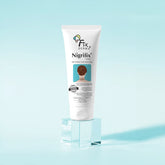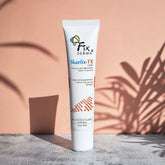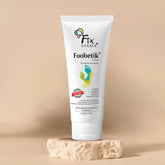Dry & Cracked Heels: Causes, Treatment, and Prevention

Dry, cracked heels can be uncomfortable and undesirable, often indicating serious health problems. With time, cracks that start in the heel area of our feet can expand and cause pain, discomfort, and even infections. Our regular lifestyle choices, such as standing for long periods, wearing open-back shoes, or neglecting foot care, contribute to this issue. Furthermore, cold weather and specific medical conditions such as diabetes and obesity can also contribute severely to this problem.
In this blog, we will dive deeper into the aspects of cracked heels, including causes, remedies, and daily foot care.
Factors Causing Dry & Cracked Heels
There are certain factors that influence the development of dry and cracked heels. In most cases, the cracks on the heels are unnoticeable but they can gradually become uncomfortable if left untreated. On the other hand, in certain cases, dry and cracked heels are a major problem for many people and are caused by numerous factors. The most common ones include:
Lack of Moisture
When our heels don't get enough moisture, they dry up and become hard. The lack of elasticity in the skin leads to the development of the cracks. Regularly moisturize your feet, especially heels, to keep them soft and supple and less prone to cracks.
Environmental Factors
Cold, dry weather and low humidity drain moisture from the skin, making it dry and fragile. Ankle cracks are more severe when our feet are subjected to extreme weather, like, when we walk barefoot on uneven terrain or wear sandals with exposed heels.
Health Conditions
Diabetes and obesity are two major contributors to dry, cracked heels. Diabetes causes decreased blood flow to the feet, which makes them dry. Obesity increases pressure on our heels, causing the skin to split. Certain skin diseases, such as eczema and psoriasis, can cause our feet's skin to dry up and enhance the cracks. These conditions hinder the skin's natural moisture barrier, causing dry and cracked heels.
Improper Footwear
Another contributing factor that leads to dry, cracked heels is wearing unsuitable footwear. Open-back shoes, such as flip-flops or sandals that lack proper support, cause the skin on our heels to stretch and break. Long periods spent standing, particularly on hard surfaces, can also cause the skin of the heel to become dry and hard. Always select footwear that protects and supports your heels to keep them from cracking.
Daily Foot Care Routine to Prevent Cracked Heels
Importance of Regular Cleaning
Our feet need to be cleaned regularly to keep them healthy and free of infections. Wash your feet every day using warm water and mild soap to remove dirt, sweat, and germs, especially between the toes and beneath the nails. This lowers the risk of odours and infections.
Gentle Exfoliation
As part of your foot care regimen, gently exfoliate your feet to get rid of dead skin cells that cause dry, cracked heels. Pumice stones and foot scrubs are excellent for softening rough areas thus improving the skin texture of our feet. Repeat the process 1-2 times a week to maintain good feet health.
Use the Right Moisturizer
To properly hydrate dry foot skin, use a foot lotion containing moisturizing components such as urea, glycerin, and shea butter. Apply the solution regularly, especially after exfoliating, to restore moisture and prevent dryness of the foot skin.
Try Fixderma Fidelia Foot Cream To Moisturize Your Feet Everyday
With Fixderma Fidelia Foot Cream, enjoy intense moisturizing every day. The formulation is enriched with urea and lactic acid for quick absorption and non-greasy hydration of foot skin.
Specialized Treatments for Severe Cases
Benefits of Foot Soaks
Epsom salt foot soaks in warm water can help soften hard and dry skin around damaged heels. Epsom salt helps heal heels by increasing blood circulation and moisturizing dry, cracked skin. Adding essential oils such as lavender can augment the calming effect and offer antimicrobial properties.
DIY Foot Masks
A mixture of honey and coconut oil profoundly hydrates our heels, while mashed banana or avocado with olive oil has nutrients that help repair broken skin. Apply these masks before going to bed and cover them with socks to absorb moisture and soothe hard and cracked heels overnight.
Visiting a Podiatrist
When home cures fail, visit a podiatrist for a tailored cure to treat your cracked heels. Medical professionals can prescribe specialized moisturizers, bespoke orthotics, or skin debridement to properly treat chronic heel fissures. If the issue gets worse, prescription lotions with urea or salicylic acid can be administered to soften thick heel skin.
Recommended Foot Cream: FixDerma Foobetik Foot Cream
Fixderma Foobetik Foot Cream is a dermatologist-approved foot cream that is specially crafted for diabetic foot care, offering targeted relief and protection for dry and cracked heel problems.
Fixderma Foobetik Foot Cream Benefits
|
Ingredient |
Benefit |
|
Urea and Lactic Acid |
Deep hydration and exfoliation |
|
Tea Tree Oil |
Natural antibacterial benefits |
|
Shea Butter |
Intense moisturization and soothing properties |
- Texture: Non-greasy, quick absorption
- Effectiveness: Heals cracked heels and dry feet skin, forming a protective barrier against foot infections
Preventative Steps For Cracked Heels
Wear Supportive Shoes
Put on closed-back, well-fitting shoes that will adequately support and cushion your heels. This helps to distribute pressure uniformly and lowers the risk of heel cracking.
Avoid High Heels and Flip-Flops
High heels can put a strain on your heels, leading to dryness and cracking over time. Similarly, flip-flops expose your heels to dryness and chafing while providing very little support.
Drink Plenty of Water
Hydrating your body from within is a must for healthy skin, especially the skin on our heels. Drink plenty of water throughout the day to keep your skin moisturized and supple.
Use a Humidifier
Use a humidifier in your home during the winter months to maintain the ideal moisture levels in the air. This keeps your skin, notably your heels, from drying out in the air.
Takeaway
Consistency is important when it comes to foot care. Make foot care a part of your daily routine to help prevent and treat dry, cracked heels. Every step you take toward healthier and softer feet makes quite an impact; whether it's moisturizing daily, opting for supportive footwear, or including soothing foot soaks into your weekly footcare routine. Following basic precautionary steps can help you prevent and treat dry and cracked heels.








